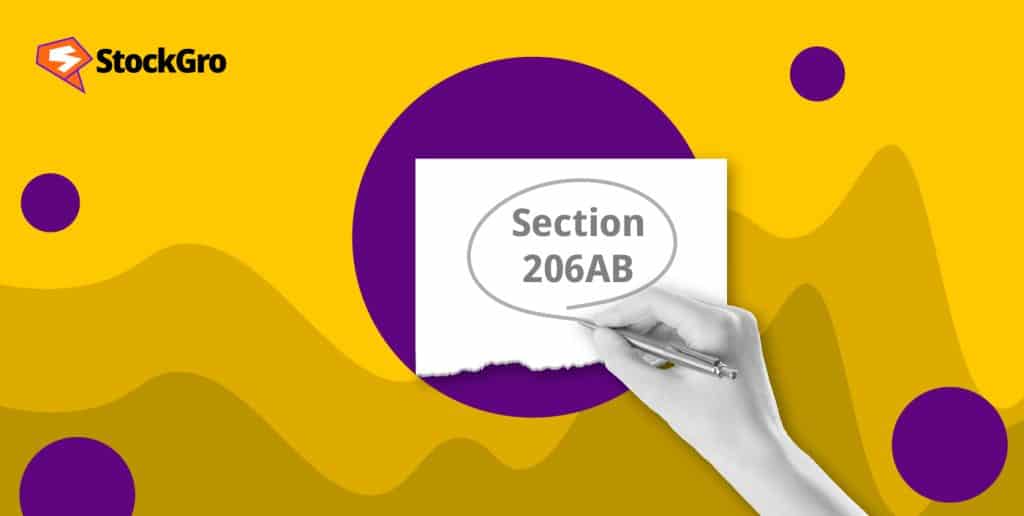
In this article, we’re going to talk about Section 206AB of the Income Tax Act, find out which taxpayers are eligible for penalties under this Act, what these penalties are, and how to calculate them to figure out your liability in case this section has been applied to you.
What is Section 206AB of the Income Tax Act?
Section 206AB of the Income Tax Act is a provision that increases the Tax Deducted at Source (TDS) burden on certain taxpayers who haven’t filed their Income Tax Returns (ITRs). This section was introduced in 2021 and it acts as an incentive for taxpayers to file their returns on time.
Who can this section be applied to?
This section of the Income Tax Act is applied to specified persons who fulfil the following conditions:
- The taxpayer in question has not filed income tax returns for two assessment years before the current year when taxes are due. For instance, if taxes are due in 2023-24 and the taxpayer has not filed a return for both 2022-23 and 2021-22, then this section is applicable.
- The due date for filing the returns for these previous years has also expired. This is included to make sure that the taxpayer doesn’t still have a window to file those returns.
- The total TDS amount deducted in the previous two financial years is ₹50,000 or more.
When can this section not be applied?
There are some conditions under which you will not be eligible to be penalised under Section 206AB of the Income Tax Act.
- This section doesn’t apply to income earned from salaries. This means that your employer cannot deduct extra TDS on your salary even if you haven’t filed your ITR.
- Exemptions also apply to payment of arrears of salary, winnings from lotteries, puzzles, or horse races, or cash payments exceeding a certain limit.
- Non-resident taxpayers who don’t have a permanent business presence in India are also not eligible to be penalised under this Section.
- Individual taxpayers or HUFs who don’t have incomes from businesses or professions can also be exempted. This also applies to individuals whose gross receipts or gross turnover from business in the preceding financial year are below ₹50 lakh and ₹1 cr respectively.
CTA: What is ITR
TDS Rate Under Section 206AB of the Income Tax Act
If a taxpayer is not eligible for an exemption and fulfils all criteria for eligibility as listed above, they are liable to paying TDS at:
- Twice the rate specified in the relevant section of the TDS; or
- Twice the rate in force; or
- 5% TDS rate
If the taxpayer refuses / fails to furnish their PAN number to the deductor, these rates are applicable as per Section 206AA of the Income Tax Act:
- At the rate specified in the relevant section of TDS; or
- At the rate of 20%
CTA: Tax exemption on personal loan India
Frequently Asked Questions
What happens if I mistakenly fall under Section 206AB due to a filing error?
If you haven’t filed your ITRs but believe it’s due to a mistake (e.g., technical issue, filing by a wrong person), you can rectify the situation by filing the belated ITRs for the relevant assessment years. Once these returns are filed, you can proceed to claim a lower TDS rate under Section 119 of the Income Tax Act. A rectification application from your end might also be required.
How does Section 206AB differ from Section 234C of the Income Tax Act?
Both of these sections aim to improve tax compliance and timely filing, but there are some key differences:
- Section 206AB: Focuses on deterring non-filing by increasing TDS burden on specific taxpayers.
- Section 234C: Disallows certain deductions and exemptions if the taxpayer doesn’t file their ITRs within a specified timeframe.
Can I avoid the higher TDS under Section 206AB by filing an estimate of my tax liability?
Unfortunately, filing an estimate of your tax liability doesn’t negate the applicability of Section 206AB. The higher TDS rate is automatically applied based on your non-filing history.
How can a taxpayer who falls under Section 206AB minimise the cash flow impact?
Here are some strategies you could consider:
- Act quickly: File pending ITRs in the previous years within their deadlines to get a lower TDS rate and potentially a refund on taxes you have already paid under a higher rate.
- Plan and budget efficiently: Manage cash flow well by adjusting spending or using savings to make sure that your net income remains above personal thresholds.
What are some alternative ways for the government to encourage ITR filing besides Section 206AB?
- Public awareness campaigns could increase focus on educating taxpayers about the importance of timely ITR filing and associated benefits.
- By simplifying filing procedures through online tools and pre-filled forms, tax authorities could make the tax process user-friendly and less time-consuming.
- Offering incentives like tax rebates or processing priority for early ITR filers could also encourage timely compliance.

